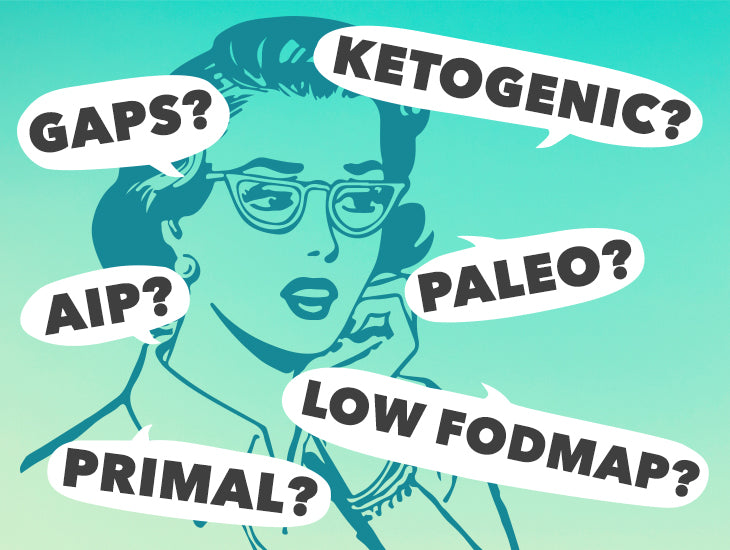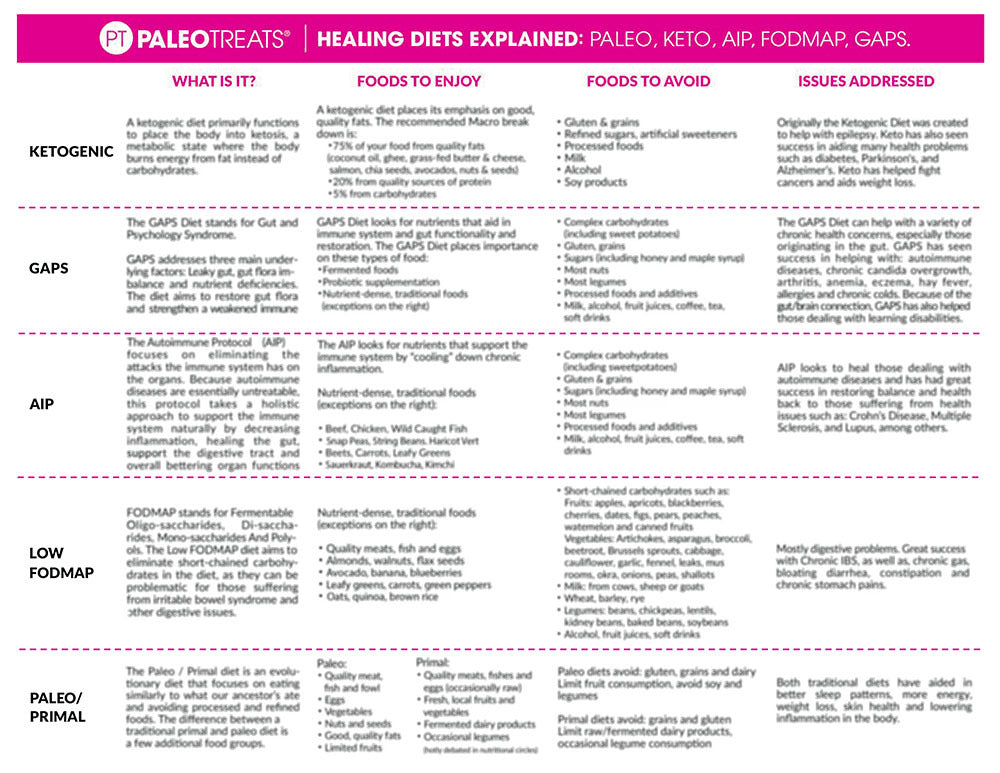- Continue Shopping
- Your Cart is Empty
Healing Diets Explained: Paleo, Keto, AIP, FODMAP, GAPS.

Is your head spinning yet? We get it, finding the right diet for you can be overwhelming. Depending on your goals, lifestyle and health concerns, it’s hard to pinpoint a healing diet that’s best suited for you and your health in mind. (Let’s be real. Google search: “Paleo Diet” and you get almost 7 million results. #FacePalm.)
Because our bodies’ functions are unique, a healing protocol needs to respect that exclusivity and complexity. Cue: Healing diets.

These diets have been developed from the notion that a specific combination of macro- and micro- nutrients, sometimes in conjunction with probiotics (and the avoidance of certain ingredients) can help against certain types of health concerns.
One of the ways to heal your gut is not listed: Going on a fast; giving your gut a break can be an excellent reset point before you begin a new diet. We've gathered all a ton of information on fasting here.
Healing diets have been around since the beginning of time, focusing on specific nutrients in whole foods to either activate or deactivate triggers in your body. These triggers in turn either diminish the bad or promote the good, ultimately stimulating better function and overall health.
To ease your mind (and sorting through 7 million Google results), we’ve explained the top 5 healing diets – what they are, what you’ll need to consume/avoid and what health issues they’ve typically helped with.
Healing Diet Options Explained:
KETOGENIC DIET
What is it?
A ketogenic diet primarily functions to place the body into ketosis, which is a metabolic state where the body burns its energy from fat instead of carbohydrates.
What will my diet look like?
A ketogenic diet places its emphasis on good, quality fats. On this diet, the recommended break down is:
- 75% of your food from quality fats (coconut oil, ghee, grass-fed butter and cheese, salmon, chia seeds, avocados, nuts and seeds)
- 20% from quality sources of protein
- 5% from carbohydrates
What foods will I need to avoid?
- Gluten, grains
- Refined sugars, artificial sweeteners
- Processed foods
- Milk
- Alcohol
- Soy products
What health issues could this diet help with?
Originally the Ketogenic Diet was created to help with epilepsy. To date, the ketogenic diet has seen success in aiding many chronic health problems such as diabetes, Parkinson's, and Alzheimer’s and has helped fight cancers and helped with weight loss.
Intermittent (and longer) fasting is usually a part of going into ketosis, you can learn more about our experience with fasting here.
Ketogenic Diet Resources:
- Butter Coffee Recipe
- Paleo Treats Keto Box
- LEVL Breath Acetone Measuring Device
- Ketologic - Ketogenic Diet and Lifestyle
Recommended Reading:
- The Wicked Good Ketogenic Diet Cookbook
- The 3 Week Ketogenic Diet
- The Essential Keto Snacks Cookbook
- The Truth About The Ketogenic Diet
GAPS DIET
What is it?
The GAPS Diet stands for Gut and Psychology Syndrome. This protocol addresses three main underlying factors: leaky gut, gut flora imbalance and nutrient deficiencies. The diet aims to restore gut flora and strengthen a weakened immune system by eliminating pathogenic bacteria.
What will my diet look like?
GAPS Diet looks for nutrients that aid in immune system and gut functionality and restoration. The GAPS Diet places importance on these types of food:
- Fermented foods
- Probiotic supplementation
- Nutrient-dense, traditional foods (exceptions below)
What foods will I need to avoid?
- Complex carbohydrates (including sweet potatoes)
- Gluten, grains
- Sugars (including honey and maple syrup)
- Most nuts
- Most legumes
- Processed foods and additives
- Milk, alcohol, fruit juices, coffee, tea, soft drinks
What health issues could this diet help with?
The GAPS Diet can help with a variety of chronic health concerns, especially those originating in the gut. GAPS has seen success in helping with: autoimmune diseases, chronic candida overgrowth, arthritis, anemia, eczema, hay fever, allergies and chronic colds. Because of the gut/brain connection, GAPS has also helped those dealing with learning disabilities.
GAPS Diet approved:
Recommended Reading
AIP DIET
What is it?
The Autoimmune Protocol (AIP) is a diet focused on eliminating the attacks the immune system has on its organs. Because autoimmune diseases are essentially untreatable, this protocol takes a holistic approach on supporting the immune system naturally by decreasing inflammation, healing the gut, supporting the digestive tract and overall bettering organ functions through diet.
What will my diet look like?
The AIP looks for nutrients that support the immune system by “cooling” down chronic inflammation. Foods include:
- Nutrient-dense, traditional foods (exceptions below)
What foods will I need to avoid?
Some basic Paleo principles are not suitable for this protocol because their chemical makeup can irritate and inflame the gut microbiome. Foods that need to be avoided:
- Nightshades
- Eggs
- Nuts and seeds
- Gluten, grains, dairy, soy
- Any additives (gums, carrageenan)
What health issues could this diet help with?
AIP looks to heal those dealing with autoimmune diseases and has had great success in restoring balance and health back to those suffering with health issues such as: Crohn’s Disease, Multiple Sclerosis, and Lupus, among others.
Recommended Reading & Resources
LOW FODMAP DIET
What is it?
FODMAP stands for Fermentable Oligo-saccharides, Di-saccharides, Mono-saccharides And Polyols. The Low FODMAP diet aims to eliminate short-chained carbohydrates in the diet, as they can be problematic for those suffering from irritable bowel syndrome and other digestive issues.
What will my diet look like?
- Nutrient-dense, traditional foods (see exceptions below)
- Quality meats, fish and eggs
- Most nuts, seeds and quality fats
- Fruits, vegetables (with the exceptions below)
- Some grains
What foods will I need to avoid?
- Short-chained carbohydrates such as:
- Fruits: apples, apricots, blackberries, cherries, dates, figs, pears, peaches, watermelon and canned fruits
- Vegetables: Artichokes, asparagus, broccoli, beetroot, Brussels sprouts, cabbage, cauliflower, garlic, fennel, leaks, mushrooms, okra, onions, peas, shallots
- Milk: from cows, sheep or goats
- Wheat, barley, rye
- Legumes: beans, chickpeas, lentils, kidney beans, baked beans, soybeans
- Alcohol, fruit juices, soft drinks
What health issues could this diet help with?
Mostly digestive problems. Chronic IBS has seen great success as well as those experiencing chronic gas, bloating, diarrhea, constipation and chronic stomach pains.
Recommended Reading
Low FODMAP approved:
PALEO / PRIMAL DIET
What is it?
The Paleo / Primal diet is an evolutionary diet that focuses on eating similarly to what our ancestor’s ate and avoiding today’s processed and refined foods. The difference between a traditional primal and paleo diet is a few additional food groups.
What will my diet look like?
- Quality meat, fish and fowl
- Eggs
- Vegetables
- Nuts and seeds
- Good, quality fats
- Limited fruits
Primal
- Quality meats, fishes and eggs (occasionally raw)
- Fresh, local fruits and vegetables
- Fermented dairy products
- Occasional legumes (debated hotly in nutritional circles)
- Nuts and quality fats
What foods will I need to avoid?
Paleo diets avoid: gluten, grains and dairy
Limit fruit consumption, avoid soy and legumes
Primal diets avoid: grains and gluten
Limit raw/fermented dairy products, occasional legume consumption
What health issues could this diet help with?
Both traditional diets have aided in better sleep patterns, more energy, weight loss, skin health and lowering inflammation in the body.
Paleo Resources:
- Breakfast Egg Muffins Recipe
- Paleo Dessert Boxes
- Kasandrinos Olive Oil
- Grass Fed Meat Shipped To Your Door
- Dry Farms Wine
- Bare Bones Broth
Recommended Reading:
If you'd like to read more of Katie's work, head on over to TheWellU.com where she blogs and offers some pretty tasty looking recipes!
We usually send out emails once or twice a week. We aim to be useful, so you'll hear about water fasts, hard workouts, our favorite recipes, and why we (well, Nik) runs up a mountain with a mouthful of water on a regular basis.

- Healing Fibromyalgia with Paleo, by Kelli Tennant
- How I Cured My Allergies Using Paleo
- Paleo Diet & Heart Health
- Paleo Meal Prep Tips
- Paleo Treats Podcast, Episode 43: Going Deep With Peter Defty
This guest blog post is from Katie Merritt, a personal trainer, food blogger and nutritional therapist in progress. Katie hails from the good ole’ Midwest (Iowa) and is an avid runner, CrossFitter and connoisseur of coffee.
Nik Hawks
Nik Hawks helps run the show at Paleo Treats. Fascinated by humans in all their strange glory, Nik is harnessed in and pulling hard in pursuit of excellence with the rest of the PT Crew. Enjoy!
4 Comments
Gina
Helpful ty!
miguel
You left out the Wahls Protocol. From what I read, is very good for Autoinmune issues (lupus, mctd, RA)
Ria
Thank you for putting this together! A very informative article.
Manuela ferrari
Thanks for sharing this! Great article! Just a small comment…keto diet includes cheese as well, organic and grass fed when possible, I think it’s important to include it in the list. My two cents. ?







